Toll motorways

France has a substantial motorway system, which allows motorists to save considerable amounts of time when making long distance journeys. In order to make this possible, the French government opted to allow private companies build and manage many of the motorways on their behalf.
In order to cover their costs and fund new improvements, the government allows these private companies to charge tolls for their use, particularly as there is no vehicle tax levied on private cars in France.
Consequently, if you're visiting France from another country, you'll need to factor the cost of tolls into your budget. Typically, tolls are charged at around €1 per 10 kilometres for a typical car, so for a long distance journey the cost can build up.
Not all autoroutes are tolled. Many motorways are free in the vicinity of major cities, as are the A26 near the Channel ports, and the A75 north-south motorway between Clermont Ferrand and the south coast (with the exception of the bit over the Millau Viaduct).
However, the one thing to bear in mind is that autoroutes are fast, direct roads with junctions built under or over the motorway. This gives the advantage that whatever you spend on tolls, you can potentially offset against fuel savings - after all, you won't have frequent cases of having to slow down, speed up and even stop every time you reach a roundabout or a town/village. Plus there is the considerable time (and stress) saving this comes with.
Using the toll motorways
All toll motorways are signposted
![]() ,
so you'll always know beforehand that a toll section is coming up. This is
the case both on the motorway itself, and at junctions and on their
approaches. If you choose not to follow
,
so you'll always know beforehand that a toll section is coming up. This is
the case both on the motorway itself, and at junctions and on their
approaches. If you choose not to follow
![]() , free
routes are always signposted once you leave the motorway.
, free
routes are always signposted once you leave the motorway.
On most toll motorways, you will encounter two toll booths. At the first, you'll be issued a ticket, which you keep until you leave the motorway or reach the end of the tolled section. At this point, you'll encounter a second toll booth, which is where you insert the ticket and pay the appropriate fee.
Such is the expansive nature of the toll motorway system, you can travel several hundered kilometres before you encounter the second toll booth. However, there are some short tolled routes, particularly in urban areas, where you pay a flat fee at the first toll booth you encounter. Examples of this include the A154 south of Rouen and the A36 between Mulhouse and Belfort.
When you approach a toll plaza, signs will tell you what payment methods are accepted:

Singage on the approach to the barrière de péage de Hordain,
on the A2.
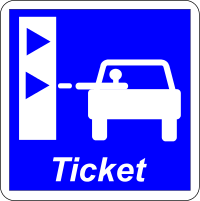 |
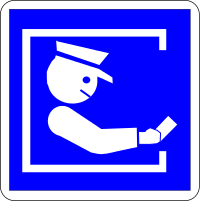 |
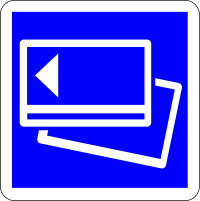 |
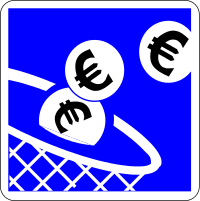 |
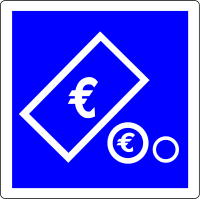 |
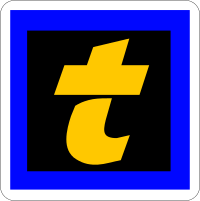 |
| take ticket |
manned booth card, cash, cheque accepted |
cards accepted |
cash accepted change given |
cash accepted change given |
télépéage accepted |
At the plaza itself, look at the overhead signs - these will tell you which lanes are open or closed, and in some cases which payment methods are accepted. A generic green arrow means that all payment methods will be accepted. Some lanes are dedicated to télépéage only, so make sure you don't use these lanes unless you have a tag (we'll discuss this further later).

Overhead signs showing accepted
payment methods, with the
X denoting
a closed booth.

Typical toll payment machine -
left to right, ticket input (1), payment card slot (2), adjacent coin slot,
green receipt button (3); vehicle class and price shown above.
How much will I have to pay?
As mentioned in the introduction, the amount you pay will normally depend on the distance travelled, and a typical charge for an ordinary car will equate to roughly €1 for every 10 kilometres travelled. Naturally, you'll pay more if you are towing a caravan or driving a larger vehicle.
To find out how much you will likely need to pay, please take a look at the official Autoroutes website. This will ensure you'll always have access to the most up-to-date information.
It is recommended that you keep a reasonable amount of cash with you. Debit cards may work, but this can depend on your bank, and credit cards are generally declined.
However, it is possible to make free journeys in some areas, if you are making a local journey between junctions; the A64 in southern France is an example of this, which is a consequence of an old national road being upgraded to motorway. You'll still be required to take a ticket, but when you reach the second toll both, the price shown will be zero.
Word of advice: If you have a roof box or bikes on on the roof of your car, be cautious as payment machines may think your car is something bigger - if it shows anything other than Class 1, use the intercom to tell the operator, as they can verify this using cameras and change the category accordingly.
Where's the toll booth?
On some of the stretches of motorway, toll booths have been replaced by free-flow tolling.
This works in a similar way to the Dartford and Mersey Gateway river crossings - you don't pay at the time of using the road. Your vehicle's deatils are recorded by cameras mounted on gantries, and the motorist enters the registration number and payment details via a dedicated website.
For further details, please take a look at our dedicated page.
Are there any busy times?
Toll motorways are usually a pleasure to use. In fact, all rural roads will be, as they are generally quiet. However, toll plazas on the major north-south motorways are notoriously prone for their traffic jams during the Ascension week and more so during main summer holiday period.
In fact, the first two weekends in August are so busy, that all long-distance coach travel is banned on the the two Saturdays concerned (local travel and journeys involving travel between Calais/Dunkerque and Belgium are permitted).
To avoid these traffic jams, you may wish to be a "Cunning Bison"...
So what's this télépéage all about?
Télépéage is an electronic payment method, which involves placing a small electronic tag in your vehicle's windscreen. By using a tag, users don't need a supply of change, as payment is taken from a designated bank account on a monthly basis via direct debit.
Another advantage is that many toll plazas have designated express lanes, so there's no need to queue up behind those paying on the spot. Normally, you would be able to proceed through the lane at a steady 30km/h without the need to stop at all.
If you are using a road with free-flow tolling, sensors mounted on the gantry will read the tag in place of the cameras reading the registration plate. Your account will then be charged in the usual way.
Whilst those who are making an
odd journey are not really going to benefit, those who travel long distances through
France or visit regularly might consider the usage fees to be worth paying
for the convenience:
- €10.00 one-off account set-up fee (+ VAT at 20%)
- €20.00 refundable deposit
- €6.00 annual management fee (+ VAT)
- €5.00 monthly usage fee (+ VAT, only charged up to a
maximum €10.00 per year)
You can find out more about the toll tag at the Liber-T website.
UK residents can save
money!
Order your tag from
Emovis,
and you won't need pay the set-up fee thanks to our friends at
Rhino Car Hire!

A Bip & Go toll tag as
issued by the toll motorway comapany Sanef and their UK subsidiary Emovis.
Small Print
Voie Rapide does not endorse any third party company. Rhino Car Hire has
provided the discount code as a gesture of goodwill in order to help
motorists
save money, you don't even need to hire a car from them. Prices
shown on the Emovis website are in Euros, but the company uses a commercial
exchange
rate that is mid- market +2% at the time of billing. This means
you'll pay less than using a debit or credit card as market rates are better
than those on the
high street (and will help to
offset some of the account
fees!).
Photo credits
Halte Péage sign is
taken from an original by Camille Bonnais and is used under
this Creative Commons license
Péage 400m sign is
taken from an original © Raimond Spekking
and is used under
this Creative Commons license
Toll plaza is
taken from an original © Raimond Spekking
and is used under
this Creative Commons license
Payment machine sign is
taken from an original by Sebleouf and is used under
this Creative Commons license